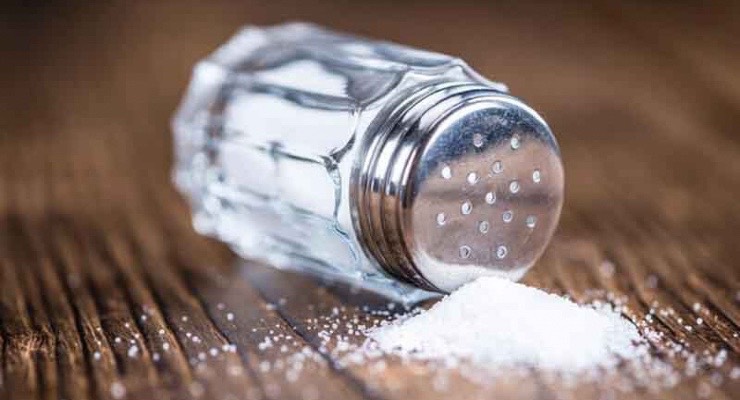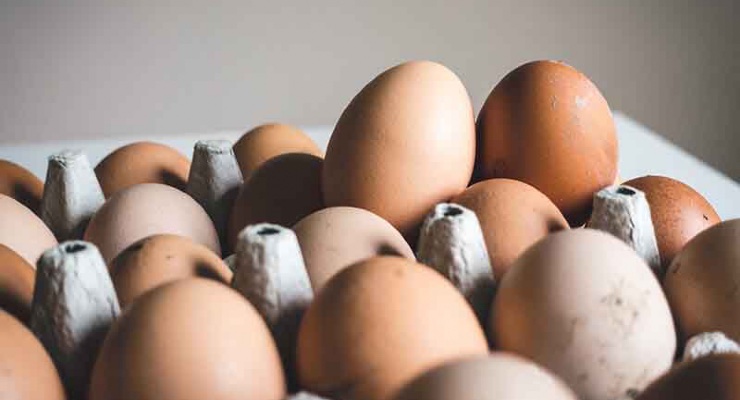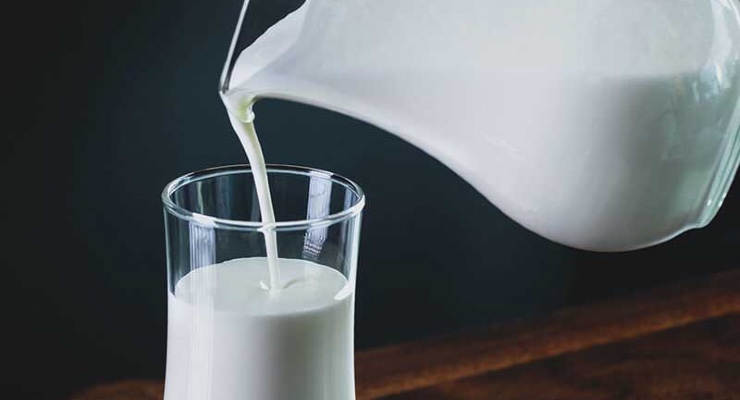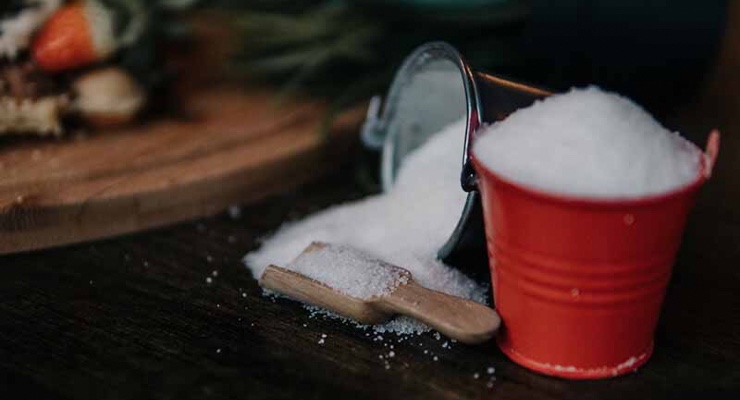
Flour
The most important raw material in the bakery is flour, which is obtained by grinding the inner part of the grain. Flour can also be made from other grains such as rye, oats, barley, millet, buckwheat, and corn, of which wheat is the most important and widely used. Wheat flour has many different types and will influence the quality of your end product.
The average composition of wheat flour is as follows:
- 68% Starch
- 13% Protein
- 15% Water
- 2% Mineral substances
- 2% Fat
Wheat flour contains two distinct proteins: "gliadin" and "glutenin." These proteins are insoluble in water and form gluten during kneading. This gluten helps dough rise, ensuring the elasticity and consistency of the dough. Higher gluten content in the flour traps more gas during proofing and yields a lighter, higher loaf. Flour with high gluten content is called strong flour. Most bread recipes, especially croissants, require strong flour (protein content of at least 11%) because it must be fluffy and airy.
Proteins form gluten, which can be imagined as a network of protein substances. They are tough and stretchy and have the property of holding together other ingredients such as water and starch. Gluten is, therefore, very important for a resilient dough and to obtain a resilient dough.
Other factors that are essential for flour quality are "the degree of extraction" and "the ash content." The higher ash content indicates that the flour contains more of the germ, bran, and the outer endosperm. Lower ash content means that the flour is more highly refined. This can also determine the colour of the flour, the water-binding capacity, and the protein percentage.

Water
Water performs several functions in a dough:
- Without water, there is no connection of the ingredients, and the formation of the dough would be impossible.
- It is a carrier of inorganic salts and natural chemical compounds (yeast nutrient and dough acidity).
- It maintains the temperature of the dough.
- It distributes the heat through the bread during baking.
- It maintains the freshness of the baked products.

Salt
We add salt to a dough to improve the taste and flavour. It also aids in the gluten development process. Salt also regulates the fermentation process. Its addition controls yeast growth, which results in a nice and even crumb structure.

Yeast
The primary raw material used in bakery is yeast. Yeast is a single-cell organism that is obtained industrially by enriching molasses with nitrogen and phosphorus salts, vitamins, and minerals. There are several varieties of yeasts: "brewer's yeast," a liquid yeast used primarily for fermentation processes in alcoholic beverages like beer and wine, and "baker's yeast" that is suitable for the bakery sector.
Baker's yeast comes in several forms: fresh yeast, active dry yeast, and instant yeast. Fresh yeast is most commonly used by professional bakers. Active dry yeast and instant yeast are dried yeasts that have a longer shelf life and are inexpensive.
In bread making, yeast provides a specific flavour to the dough. The most important property of yeast is that it converts sugar in the dough into carbon dioxide and ensures the dough to expand or rise as gas (carbon dioxide) forms air pockets or bubbles, giving the baked product a soft and spongy texture.

Eggs
Eggs play an important role in bread preparation and confectionery. The functions and benefits of eggs are as follows: a binder, a volume enhancer, a colorant, a firming agent, an adhesive, and an emulsifier.
Whole eggs, yolks, and egg whites are available separately. The advantage of this is that it saves a lot of work when using a large number of eggs. There will be no broken shells in the mixture and no yolk in the egg whites, which is important because in some preparations, there should be no egg yolk in the egg whites.
Another possibility is egg powder, which is also available as whole egg, egg yolk, and egg white. The downside is that it is very expensive, but the shelf life is much longer.

Milk
When cows are milked, we obtain raw milk. The baker can already purchase raw milk from the farmer. It is important to immediately place the milk in a clean refrigerator because unpasteurised milk can carry harmful bacteria and other germs. Usually, the milk is collected by the dairy, which will then package and treat the milk for a longer shelf life.
Milk contains milk fat, and these fats provide energy. The essential nutrients in milk are calcium, protein, carbohydrates, and vitamin B12.
As a baker, you can purchase milk as raw milk, pasteurised milk, or milk powder.
Milk powder is obtained by removing the water present in the milk. You will get around 1/7 of milk powder out of the total weight of the milk.
The importance of milk powder is that it has a longer shelf life than liquid milk. If properly packaged and stored in a cool, dry place, it can last for years. Furthermore, it will help to free up space in your refrigerator.

Butter
Butter is often used in bread recipes. It provides not only taste and flavour but also makes baked goods much softer and tender in texture. Butter is obtained from cow's milk, and it can also be made from milk from goats, sheep, and other mammals.
Butter contains 82-84 percent milk fat, and the rest is mostly water. It’s consistency changes depending on the temperature.
Margarine consists of vegetable and animal fats. Margarine is also widely used in the baking industry because it was developed as an inexpensive butter substitute. Nowadays, the composition of the margarines has been so refined that there is a range for different applications and preparation methods for certain recipes.

Sugar
There are different types of sugars, each with a slightly different effect. For example, some sugars dissolve slower while others dissolve faster. Using the right sugars in certain recipes is important to obtain the desired taste and structure in baked products.
These are the most commonly used sugars in baking:
- Cane or beet sugar (sucrose)
- Milk sugar (lactose)
- Grape sugar or dextrose (glucose)
- Fruit sugar or levulose (fructose)
Cane or beet sugar is the most popular and is usually used in crystal form. Its sweetness value is 100. Sugar adds sweetness, colour, and crispness to baked products. Cane or beet sugar is also available in powdered form (powdered/icing sugar). Powdered sugar dissolves faster, which is important for some recipes. Crystal sugar comes in different types of coarseness, such as castor sugar, fine sugar, and ultra-fine sugar. The type of sugar used depends on the desired result.
Glucose is also referred to as dextrose. It is often found in bread improvers and can be used in certain confectionery recipes. The relative sweetening value is around 70-80.
Lactose is a type of sugar found naturally in milk. It has a low relative sweetness of 20. Lactose enhances the browning of baked products.
Fructose is a simple sugar found in many plants. It has a strong sweetness of around 140 and is the most water-soluble of all the sugars. It can be quite expensive.
"Summary"
- The main raw material in baking is wheat flour, which contains gluten that gives a good connection with yeast and makes the dough rise.
- Water binds together the raw materials, ensures heat transfer, and facilitates evaporation on cooling.
- Salt ensures the taste, development of gluten during the fermentation process, and gives a nice crumb structure.
- Yeast is a living organism that gives a specific taste to the product. It mainly ensures the rising of the dough, provides vitamin B, and contributes to a nice crust and crumb structure.
- Eggs are the most versatile raw material, acting as a binder, volume enlarger, colorant, firming agent, adhesive, and emulsifier.
- Milk contains milk fat, which ensures full flavour in bakery products. It provides moisture to the preparation and is a source of vitamin B12, carbohydrates, calcium, and protein.
- Fats can be mainly divided into butter and margarine. Butter comes from cows, gives a rich taste, but is more expensive than margarine. Margarine is mainly vegetable-based and can be used for specific applications because the composition can vary according to the application. It is usually cheaper.
- Sugars: there are different types of sugars, of which cane or beet sugar is the most commonly used. Other types include lactose, glucose, and fructose. Manufacturers of mixes often use different sugars because of their various properties and operating times.
Lesson 2


